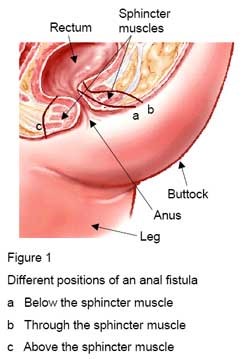An anal fistula is an abnormal connection between the lining on the inside of your anal canal (back passage) and the skin near your anus.
Most anal fistulas are caused by an abscess (a collection of pus) which has developed in your anal canal. The pus then finds the least resistant tract to your skin. A fistula happens when the track, made by the pus on the way to the surface of the skin, stays open. (see fig.1)
Most anal fistulas are caused by an abscess (a collection of pus) which has developed in your anal canal. The pus then finds the least resistant tract to your skin. A fistula happens when the track, made by the pus on the way to the surface of the skin, stays open. (see fig.1)

Are there any alternatives to this surgery?
Most anal fistulas do not heal on their own. Surgery is usually needed to treat the problem.
What happens during anal fistula surgery?
Surgery for anal fistula is usually performed under a general anaesthetic.
Types of surgery available:
• Fistulotomy • LIFT ( Ligation of intersphinteric fistula tract) • VAAFT ( Video assisted anal fistula treatment ) • Laser fistula Surgery (FiLAC) (The procedure consists of delivering laser energy a within the lumen of fistulas by means of a radial fiber which is slowly withdrawn from the external orifice. Laser ablation is limited to the lumen of fistulas making the technique 'sphincter-saving) • Sometimes a rubber tube ( SETON) will be inserted and to drain the abcess and then 2nd surgery needed
To lessen the risk of bowel incontinence (when you pass a motion without wanting to) your treatment may involve several operations over a number of months. The type of surgery you need will depend on where the fistula is.
Anal fistula surgery summary
An anal fistula can cause continued infection and pain. Symptoms usually get worse without an operation.
Most anal fistulas do not heal on their own. Surgery is usually needed to treat the problem.
What happens during anal fistula surgery?
Surgery for anal fistula is usually performed under a general anaesthetic.
Types of surgery available:
• Fistulotomy • LIFT ( Ligation of intersphinteric fistula tract) • VAAFT ( Video assisted anal fistula treatment ) • Laser fistula Surgery (FiLAC) (The procedure consists of delivering laser energy a within the lumen of fistulas by means of a radial fiber which is slowly withdrawn from the external orifice. Laser ablation is limited to the lumen of fistulas making the technique 'sphincter-saving) • Sometimes a rubber tube ( SETON) will be inserted and to drain the abcess and then 2nd surgery needed
To lessen the risk of bowel incontinence (when you pass a motion without wanting to) your treatment may involve several operations over a number of months. The type of surgery you need will depend on where the fistula is.
Anal fistula surgery summary
An anal fistula can cause continued infection and pain. Symptoms usually get worse without an operation.
